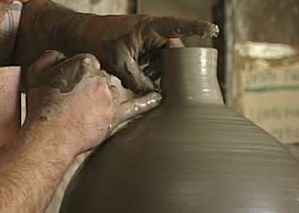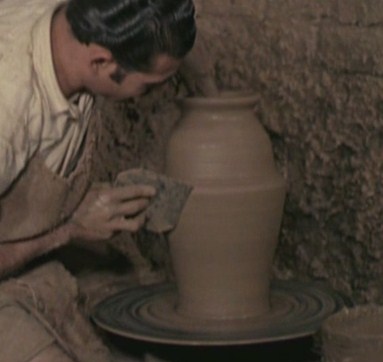

The traditional crafting technique implemented on the territory until the second half of last century, echoes the intended use of the products, basic elements designed to fulfill daily needs in pre-industrial contexts.
The crafting techniques were similar to those used in the same context in the Mediterranean area and included the digging and preparation of local clay, followed by lathing, finishing and baking.
The digging of local clay
Clay was dug in tunnels not exceeding four meters of depth, requiring the participation of several manual workers in addition to the potter. The potter's expertise was essential at this stage to identify the quality of soil and its composition, to be mixed later on, according to the desired artefact, such as water vases or food containers.
Clay preparation continued inside the workshops where different types of materials were mixed and compounds were dried in the sun. The following stages were the crushing and clearing of dust remains. Impastos were then mixed with water using one's feet, and then kneaded by hand.
Turning
In order to model the artefact, the craftsman used to use the potter's wheel, arroda, without resorting to additional tools. At some stages, s/he could however use some wooden sticks to shape it. While modelling the object, the potter used to lean against the wall, half-sitting on a wooden tilting board, that was used to set the flywheel in motion.
Once the object was shaped, the vessel was released from the lathe and its bottom was thinned. When clay started to harden, the ends were added, such as spouts, handles and plastic decorations.
The dried product was finished with a light aqueous slip, stangiu, and during a following step the tin-glaze, ammesturamentu, was applied by turning the vessel upside down and dipping only the desired parts, most commonly the mouth and the handles.
The artefact was baked only once completely dry. The drying-up process was carried out by exposing the object to the sun and required special care and control, and the correct performance of each stages, through the observation of flaws and the necessary changes of position.
Baking
Baking was carried out in vertical ovens or kilns or furnaces, fed with Mediterranean shrubs, including cistus, asphodel, myrtle and mastic tree.
Baking was a very fast one-step procedure, between five and eight hours, and was carried out following the usual heating steps, callentai, on a low heat to eliminate further moisture from the artefacts, followed by the raising of the temperature up to 900°C, affumai; during this stage clay becomes ceramic, reaching the last stage of production with the highest temperature during white heat, coi, and firing shots, cardas, which required a rapid and continuous power.
Online reference resources
Video
Artigiani della creta, by Fiorenzo Serra, 1954

